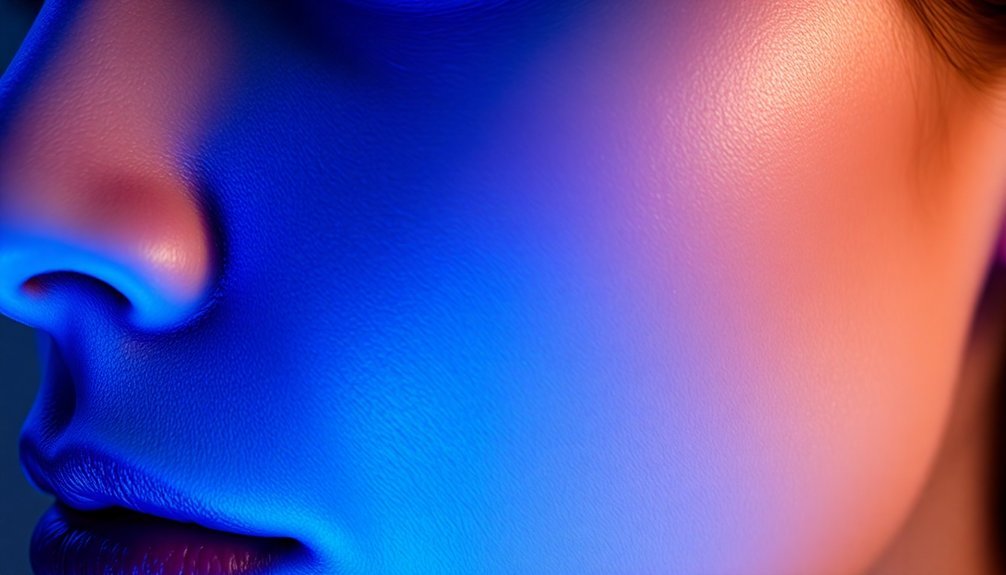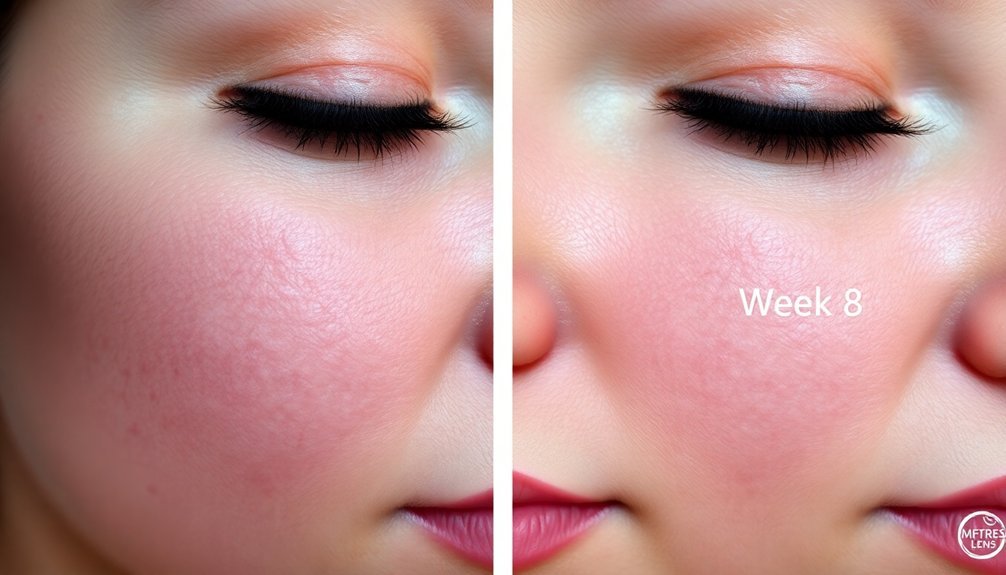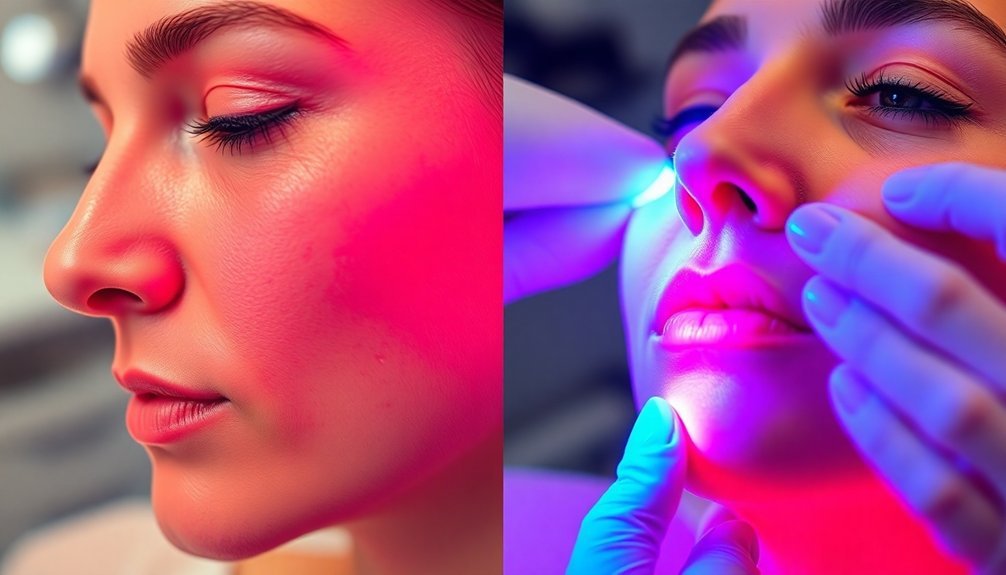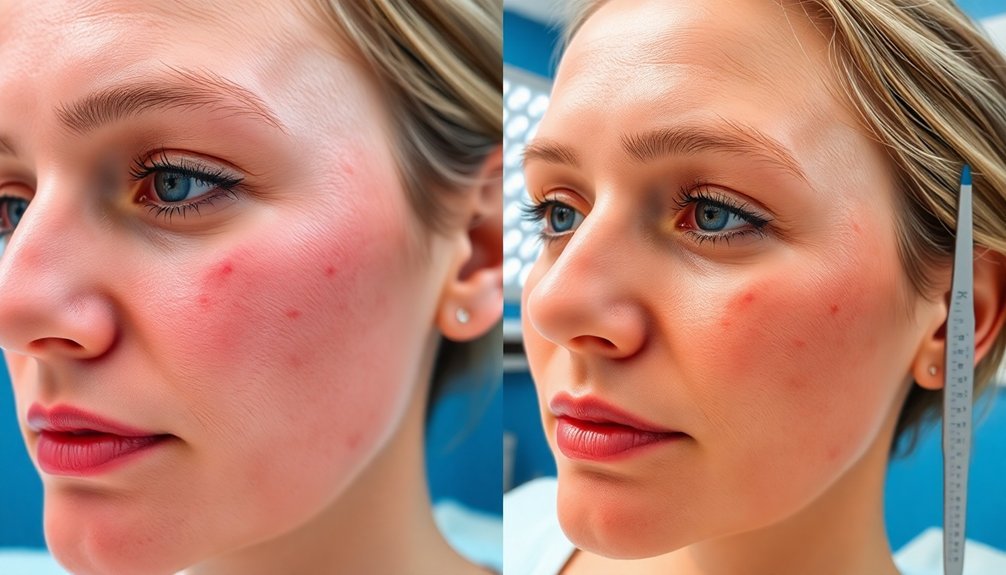Light therapy helps fade your deep acne scars quickly by triggering powerful healing responses in your skin. When specific wavelengths of light penetrate your skin's layers, they stimulate fibroblast cells to produce fresh collagen, which fills in pitted scars. The treatment also boosts blood circulation, delivering essential nutrients and oxygen to damaged tissue. Red light reduces inflammation while blue light kills acne-causing bacteria, preventing new breakouts as your scars heal. You'll typically see results with regular 15-30 minute sessions. Understanding the science behind this innovative treatment reveals why it's such an effective solution for stubborn acne scars.
Understanding Deep Acne Scars

What makes deep acne scars so challenging to treat? When inflammation from severe acne causes your pores to rupture, the damage extends deep into your skin's dermal layers. As your skin attempts to repair itself, it often produces insufficient collagen, leading to permanent depressions and textural changes that won't heal on their own.
You'll typically encounter four main types of deep acne scars. Ice pick scars appear as narrow, V-shaped indentations that penetrate deeply into your skin. Rolling scars create a wavy, uneven texture due to bands of scar tissue forming beneath the surface. Boxcar scars show up as broad depressions with sharp edges, while hypertrophic and keloid scars rise above your skin due to excessive collagen production. Professional assessment is essential for determining the most effective treatment approach for your specific scar type.
The formation process begins when your pores become clogged with oil, dead skin cells, and bacteria. When these engorged pores rupture, they trigger an infection that leads to scarring. Up to 40% of acne sufferers develop these permanent marks, particularly those who experience severe cystic or nodular acne.
While superficial scars may fade naturally, deep scars typically require targeted treatment due to their extensive dermal damage.
Light Therapy Science Explained
A beam of healing light penetrates deep into your skin's layers during light therapy, triggering multiple biological responses that help repair acne scars. When the light reaches your skin's deeper tissues, it stimulates fibroblasts to produce more collagen, which helps fill in pitted scars and smooth your skin's surface. Studies show that fibroblast activation is crucial for repairing damaged skin tissues.
You'll benefit from enhanced blood circulation as the light therapy increases blood flow to the affected areas. This boost in circulation delivers essential oxygen and nutrients to repair damaged tissue. The treatment also activates your body's DNA repair mechanisms by stimulating ATF2 proteins, which protect your cells and prevent further damage.
Different light wavelengths offer unique benefits. Red light reduces inflammation and stimulates collagen, while blue light works with photosensitizers in photodynamic therapy to achieve up to 90% acne clearance.
For deeper scars, fractional laser therapy creates microscopic wounds that trigger your body's natural healing response. These controlled injuries prompt new cell growth and collagen production specifically where you need it, while leaving surrounding healthy skin intact.
Whether you choose LED therapy, lasers, or photodynamic treatment, you're tapping into your body's natural healing abilities to fade those stubborn scars.
Different Types of Light Treatment

Red light's deeper penetration of 1-2mm into your skin makes it especially effective for treating deep acne scars, while blue light works closer to the surface to kill acne-causing bacteria.
You'll get enhanced results from blue-red combination therapy since it pairs blue light's antibacterial power with red light's healing and anti-inflammatory benefits at different skin depths.
While both options can help, selecting the right wavelength or combination for your specific scar type is vital for ideal healing and collagen production. For optimal results, treatments should utilize wavelengths between 390 and 1100 nm to target both superficial and deeper skin layers.
Red Light Penetrates Deep
Light therapy's most powerful weapon against deep acne scars comes from penetrating red wavelengths that reach 1-2 millimeters beneath the skin's surface. When this light reaches your cells, it triggers your mitochondria to kickstart natural healing processes, boosting collagen production and tissue repair where you need it most. The effectiveness of this treatment has been shown to clear acne by 70% in just 8-10 sessions.
| Benefit | How It Works |
|---|---|
| Cellular Repair | Light energizes mitochondria for self-healing |
| Blood Flow | Increases oxygen and nutrient delivery |
| Inflammation | Reduces inflammatory mediators and interleukins |
You'll find that red light's deep penetration offers unique advantages over other light therapies. It's working beneath your skin to enhance blood circulation, delivering crucial nutrients and oxygen to damaged areas. The light stimulates proteins like ATF2, which protect your cells from further damage while supporting DNA repair processes.
What makes red light particularly effective for deep scars is its ability to boost fibroblast production. These cells are essential for creating new collagen, which helps fill in and smooth out acne scarring. Whether you're using an FDA-approved home device or getting clinical treatments, you'll typically need 15-30 minute sessions to achieve ideal results.
Blue-Red Combination Effects
Powerful treatment combinations emerge when you pair blue and red light therapies for acne scar treatment. While blue light targets and destroys P. acnes bacteria through photochemical reactions, red light penetrates deeper to stimulate healing and reduce inflammation. The bacteria absorb the 417nm wavelength light for optimal elimination. This synergistic approach delivers a one-two punch against both active acne and existing scars.
You'll notice several benefits from this combination therapy. First, the blue light decreases oil production from your sebaceous glands while killing acne-causing bacteria. Meanwhile, red light boosts collagen production, which helps rebuild damaged skin tissue and improve your skin's texture. Together, they're more effective than either treatment alone.
The treatment process is straightforward: you'll typically receive 15-20 minute sessions twice weekly for several weeks. Sometimes, your dermatologist might apply a photosensitizing agent to enhance the blue light's effectiveness. You won't experience significant discomfort – just possible mild redness or dryness that quickly subsides.
What makes this combination particularly effective is its all-encompassing approach. While you're treating current breakouts with blue light's antibacterial properties, you're simultaneously promoting skin rejuvenation and scar reduction with red light's healing capabilities.
Near-Infrared Boosts Healing
When it comes to healing deep acne scars, near-infrared light therapy stands out as a groundbreaking solution. This powerful treatment penetrates deep into your skin, triggering multiple healing mechanisms that work together to fade even stubborn scars. At-home treatments can be easily performed several times per week for optimal results.
You'll benefit from increased collagen production as near-infrared light stimulates your fibroblasts, which helps fill in atrophic scars and restore your skin's elasticity. The therapy also boosts blood circulation, delivering essential nutrients and oxygen to damaged areas, which accelerates your skin's natural healing process.
What makes near-infrared particularly effective is its ability to reduce inflammation while improving your skin's texture through enhanced cell turnover. You won't have to worry about side effects or recovery time, as it's a non-invasive treatment that's safe for all skin types.
Whether you choose clinic treatments or at-home devices, you'll have flexibility in how you incorporate this therapy into your skincare routine.
The results you'll see are comparable to, and sometimes better than, other scar treatments. With consistent use, you can expect long-lasting improvements in your skin's appearance, making near-infrared light therapy a reliable choice for scar reduction.
Collagen Production and Healing
Red light therapy works with your skin's natural processes to boost collagen production, which is essential for repairing damaged tissue layers and filling in deep acne scars.
You'll notice improvements as the increased collagen helps rebuild your skin's structure from the inside out, promoting new skin cell growth and better tissue organization. This treatment attracts vital healing cells like fibroblasts and keratinocytes that aid in tissue regeneration.
The therapy's ability to stimulate fibroblasts means you're actively supporting your skin's healing mechanisms, leading to stronger, healthier tissue formation where scarring once dominated.
Stimulating Skin Cell Growth
Light therapy's ability to stimulate skin cell growth revolutionizes the treatment of deep acne scars through its effect on collagen production.
When you undergo LED light therapy, specific wavelengths penetrate your skin to trigger fibroblast production, which directly enhances collagen formation and tissue repair.
Red and near-infrared light therapy work together to boost your skin's healing process.
You'll benefit from increased blood circulation and cellular repair, while the light waves stimulate angiogenesis – the formation of new blood vessels that deliver essential nutrients to healing areas.
This process helps fill in atrophic scars and improves your skin's texture. The therapy increases ATP production in cells, accelerating the healing process.
You'll find that consistent light therapy sessions enhance your skin's natural healing abilities.
The treatment promotes collagen production while reducing inflammation, creating an ideal environment for scar healing.
While you're using light therapy, you're also supporting your skin's elasticity and hydration levels, which are vital for minimizing scar appearance.
Remember that while light therapy is generally safe, you'll need to follow proper guidelines to avoid potential side effects.
Don't overexpose your skin, and always protect your eyes during treatment sessions.
Repairing Damaged Tissue Layers
The repair of damaged tissue layers begins at the cellular level, where collagen production takes center stage in healing deep acne scars. When you undergo red and near-infrared light therapy, it stimulates your fibroblasts to produce more collagen, creating a natural scaffold for tissue repair.
| Healing Process | Benefits |
|---|---|
| Collagen Production | Fills atrophic scars and improves skin texture |
| Blood Flow | Delivers nutrients and oxygen to damaged areas |
| Tissue Regeneration | Supports new cell growth and repair |
| Inflammation Control | Reduces redness and promotes faster healing |
Your skin's healing mechanisms activate as collagen attracts essential cells to the wound site. The increased collagen levels don't just fill in scars – they're also improving your skin's overall elasticity and hydration. You'll notice smoother, more even skin texture as the therapy continues.
Red light therapy's ability to enhance mitochondrial energy makes it particularly effective for deep scar treatment. It's working beneath the surface to repair DNA and promote cell survival, while simultaneously supporting angiogenesis – the formation of new blood vessels that deliver crucial nutrients to healing tissues. This non-invasive approach won't damage your skin and doesn't require downtime, making it a practical choice for consistent scar treatment.
Red Light Benefits

Understanding how red light therapy benefits your skin starts with three key mechanisms: enhanced collagen production, deep tissue penetration, and reduced inflammation.
When red light penetrates your skin's layers, it stimulates fibroblasts to produce more collagen, which fills in deep acne scars and improves skin elasticity. The therapy's longer wavelengths reach 1-2mm beneath your skin's surface, targeting damaged tissue at its source.
You'll experience several transformative effects as your skin responds to red light therapy:
- Your blood circulation improves dramatically, delivering essential oxygen and nutrients to repair damaged skin cells.
- Your skin's natural healing processes accelerate as the light stimulates mitochondrial energy production.
- Your oil gland activity decreases, reducing the likelihood of future breakouts.
- Your existing acne scars fade as increased collagen production rebuilds damaged tissue.
When combined with photodynamic therapy, you can expect up to 90% acne clearance within just one month.
The treatment's non-invasive nature means you won't experience significant side effects – just mild redness or peeling in some cases.
For ideal results, you'll want to maintain regular sessions, as the benefits compound over time.
Near-Infrared Light Applications
Near-infrared light reaches far into your skin's layers, penetrating up to 4cm deep to repair damaged tissue at its source.
You'll experience increased blood flow in treated areas, which helps deliver essential oxygen and nutrients directly to scarred regions.
This enhanced circulation accelerates your skin's natural healing process while supporting the long-term reduction of deep acne scars.
Deep Tissue Penetration Benefits
Penetrating deeply into multiple tissue layers, near-infrared (NIR) light offers remarkable therapeutic potential for treating acne scars and other skin conditions. NIR wavelengths between 700-900nm can reach depths of up to 40mm through tissue, making them particularly effective for targeting deep acne scars that affect multiple skin layers.
You'll benefit most from NIR wavelengths around 808nm, which provide ideal penetration through various tissue types. When treating deep acne scars, NIR light works through several key mechanisms:
- Enhanced cellular energy production in deep tissue layers, stimulating natural healing processes
- Improved collagen production at depths of up to 2.4mm, supporting skin structure repair
- Reduced inflammation in multiple tissue layers, including the dermis and subcutaneous fat
- Increased blood flow to damaged tissues, promoting faster healing and scar reduction
Your skin's response to NIR therapy depends on factors like tissue composition and treatment area. Areas with higher fat-to-muscle ratios, such as your cheeks, allow for deeper light penetration.
This makes NIR particularly effective for treating facial acne scars, where it can reach multiple tissue layers while maintaining therapeutic intensity.
Blood Flow Healing Effects
Through its remarkable healing properties, near-infrared light therapy revolutionizes blood flow dynamics in treated skin areas.
When you undergo this treatment, the near-infrared light penetrates up to 4cm beneath your skin's surface, triggering increased blood circulation that delivers essential oxygen and nutrients directly to your acne scars.
You'll benefit from the therapy's ability to activate specialized wound healing cells and fibroblasts, which are important for collagen production and tissue repair.
The enhanced blood flow doesn't just deliver nutrients – it also supports faster cellular repair and regeneration, making your scars less noticeable over time.
What makes near-infrared light therapy particularly effective is its impact on ATP production and cellular metabolism.
As blood circulation improves, your cells receive more energy to repair damaged tissue.
This boost in cellular activity, combined with the therapy's anti-inflammatory effects, creates a favorable healing environment for your deep acne scars.
You'll notice that the increased blood flow helps reduce inflammation while supporting your skin's natural healing processes, making this non-invasive treatment particularly effective for all skin types.
Treatment Duration and Results

Light therapy sessions for deep acne scars require a strategic treatment timeline to achieve ideal results. You'll typically need 3 to 6 treatments spread across several months, with each session lasting under an hour.
While you won't see immediate changes, noticeable improvements emerge within 7-10 days after each treatment, with best results appearing weeks after your final session.
The healing journey follows a predictable pattern:
- Initial redness and mild discomfort subsides within 1-2 hours post-treatment
- Skin begins showing visible improvements around day 7
- Significant scar reduction becomes apparent by week 12
- Long-term results stabilize after completing all sessions
You'll see the most dramatic improvements about 12 weeks after completing your treatment series, with studies showing up to 72% reduction in acne scarring.
While some laser types offer permanent results, you might need maintenance treatments once or twice yearly to maintain your results.
Your specific treatment duration depends on your scar severity and skin response, making it essential to follow your provider's personalized treatment plan for best outcomes.
Professional Versus Home Devices
When choosing between professional and at-home light therapy devices for acne scars, you'll encounter two distinct options with considerable differences in effectiveness. Professional treatments deliver higher intensity light that penetrates deeper into your skin, targeting stubborn acne scars more efficiently. You'll also benefit from expert guidance, preventing potential misuse and ensuring optimal outcomes.
While at-home devices might seem convenient, they can't match the power and precision of professional equipment. You'll need more sessions with a home device to achieve similar results, and you might struggle with limited coverage areas and inconsistent application.
| Professional Treatment | At-Home Device |
|---|---|
| High-intensity light for faster results | Lower intensity requiring more sessions |
| Expert customization for your skin type | One-size-fits-all approach |
| Complete skin coverage in less time | Limited coverage area |
| Professional eye protection | Variable safety features |
| Consistent, monitored results | Unpredictable outcomes |
If you're serious about treating deep acne scars, professional treatments offer the most reliable path forward. You'll benefit from superior technology, expert oversight, and thorough coverage – factors that greatly impact your treatment's success rate and overall safety.
Combining Therapies for Maximum Results

Several treatment combinations can dramatically enhance your results when addressing deep acne scars. When you combine light therapy with other proven treatments, you'll often see faster and more significant improvements than using any single method alone.
Professional clinics routinely pair light therapy with complementary treatments to maximize your results. These strategic combinations work together to target different aspects of scar healing:
- Chemical peels + LED therapy softens your skin's surface while stimulating deeper collagen production.
- Microneedling + light therapy creates tiny channels that enhance product absorption and healing.
- Laser treatments + LED therapy penetrates multiple skin layers for thorough scar reduction.
- Subcision + light therapy releases stubborn scar tissue while promoting new collagen growth.
You'll find that these combinations work synergistically – each treatment enhances the effectiveness of the other. For instance, when you undergo microneedling before light therapy, the micro-channels allow for deeper light penetration.
Similarly, combining chemical peels with LED treatments helps your skin become more receptive to light therapy's healing properties.
While you'll need multiple sessions for ideal results, these combination approaches typically deliver more dramatic improvements than standalone treatments.
Safety and Side Effects
Understanding the safety profile of light therapy is vital before starting treatment for deep acne scars. While it's generally considered safe, you'll need to be aware of common side effects like redness, bruising, and mild swelling after treatment. You might also experience some skin peeling or temporary irritation at the treatment site.
Though rare, more serious side effects can occur. You'll want to watch for signs of blistering, burns, or severe pain. Changes in skin pigmentation and scarring are also possible, particularly if you don't follow post-treatment care instructions carefully.
To guarantee your safety, you'll need to take specific precautions. Always wear proper eye protection during treatment, and it's important to avoid sun exposure for at least 48 hours afterward. If you're pregnant or have certain photosensitivities, you shouldn't undergo light therapy.
Make sure you're working with a board-certified dermatologist who can properly assess your skin and guide your treatment. They'll help you choose between in-office procedures and FDA-approved home devices.
Before starting treatment, discuss your medical history, potential risks, and expected outcomes with your provider to guarantee you're a suitable candidate for light therapy.
Proven Clinical Research

Extensive clinical research validates the effectiveness of light therapy for treating deep acne scars.
Systematic reviews and meta-analyses confirm that LED treatments considerably reduce both inflammatory and non-inflammatory acne lesions. When you combine blue and red light therapy, studies show a remarkable 24.4% improvement in inflammatory lesions and 19.5% improvement in non-inflammatory lesions.
Clinical trials between 2018 and 2022 reveal compelling evidence for various light therapy approaches.
You'll find the most dramatic results through these scientifically proven treatments:
- Bi-weekly blue light sessions reducing inflammatory acne by 60% over 8 weeks
- Red light therapy penetrating deep beneath the skin's surface to repair tissue damage
- Combined blue-red light therapy attacking bacteria while simultaneously promoting healing
- Non-ablative lasers, like the 1,450-nm diode, effectively treating even darker skin types
Multi-center studies consistently demonstrate that light therapy isn't just effective – it's versatile.
The research shows particularly promising results when combining different wavelengths, with blue light targeting surface bacteria while red light works deeper to promote healing and reduce scarring.
Daily Treatment Protocol
Building on these research findings, a well-structured daily protocol will maximize your light therapy results. Start by cleansing your face with a gentle cleanser to remove oils and debris that could interfere with light penetration. You'll need to follow your device's specific instructions, typically scheduling treatments several times throughout the week.
After each session, apply a non-comedogenic moisturizer to maintain skin hydration, and don't forget your sunscreen during daytime hours – it's essential for protecting your skin from UV damage while undergoing treatment. You can combine your light therapy with other acne-fighting ingredients like salicylic acid or benzoyl peroxide for enhanced results.
For ideal outcomes, you'll want to use different wavelengths strategically. Red light stimulates collagen production, while near-infrared light boosts blood flow to speed healing. If you're dealing with active breakouts alongside scarring, blue-red combination therapy offers dual benefits.
While the treatment is generally safe for all skin types, watch for occasional side effects like dryness or mild irritation. Remember, consistency is key – whether you're getting treatments at a clinic or using an at-home device, stick to your schedule for the best results.
Frequently Asked Questions
Can Light Therapy Be Used During Pregnancy or While Breastfeeding?
You can use light therapy during pregnancy and breastfeeding, but you'll need to consult your healthcare provider first. While it's generally safe, avoid direct exposure to your abdomen and breast areas.
Does Skin Color or Ethnicity Affect the Success Rate of Light Therapy?
Yes, your skin color greatly affects light therapy's success rate. If you've got darker skin, you'll need adjusted treatment settings and may face higher risks of hyperpigmentation, though non-ablative lasers can still work effectively.
Will Light Therapy Help With Ice Pick Scars Specifically?
While light therapy can help improve ice pick scars, it's not the most effective treatment alone. You'll likely need to combine it with other treatments like microneedling or chemical peels for better results.
Can I Undergo Light Therapy if I Have Active Cold Sores?
You shouldn't undergo light therapy with active cold sores unless directed by your healthcare provider. While it can help treat cold sores, timing is essential. Wait until the outbreak clears or seek professional guidance first.
Does Taking Certain Medications Interfere With Light Therapy Treatments?
Yes, photosensitive medications can interfere with your light therapy treatments. You'll need to check with your doctor, as medications like acne treatments, antidepressants, and antihistamines can cause harmful skin reactions.
In Summary
You'll find light therapy to be an effective, science-backed treatment for deep acne scars. Whether you're using red light, blue light, or combination therapy, consistent treatments stimulate collagen production and speed up healing. Follow your treatment protocol carefully, and you'll likely see noticeable improvements within weeks. Remember to consult your dermatologist before starting and always protect your skin during treatment sessions.





Leave a Reply